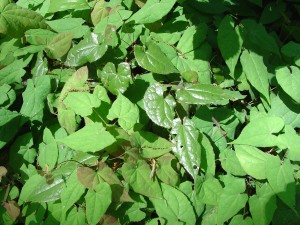Epimediums, aka barrenwort or fairy wings, are slow-growing groundcovers which are hardy in USDA hardiness zones 4-9. Foliage varies by species, variety, and the season of the year. Most are deciduous, but some evergreen in the Southern Appalachian region (zones 6 and 7).
The leaves of some may be chartreuse in spring, green in summer, and red in the fall. Some varieties have red or silver leaves in the summer. The leaves are asymmetrical heart shaped which attributes the name “fairy wings”.
Also, floral shapes earn them the name “bishop’s cap”. There are dozens of species and varieties. Epimediums bloom from late winter (March) to mid- spring (early May) over a 1 to 2 week span. Colors range from pink, red, violet, white, or yellow flowers. Flowers attract early-arriving butterflies and hummingbirds.
Trying to predict the ultimate dimension of a groundcover is foolhardy, particularly the genus Epimedium with so many species and varieties. Epimediums vary between 6 -12 inches in height and 12 – 18 inches in spread. Water them thoroughly and apply an organic-based mulch at planting time.
Epimediums are slow growing the first 2-3 years. Epimediums thrive in part sun to part shade (morning sun and afternoon shade). They handle average garden soils that are well-drained and moderately acidic. They ask for little maintenance once established.
Get plants off to a good start by regularly watering and feeding them. Use a slow-release fertilizer according to label directions at planting time and again each spring thereafter. An alternative is to feed monthly from April to mid-August with a water-soluble plant food.
In late winter cleanup fallen leaf matter by mowing over the debris before flower buds appear. The groundcover looks better and allows all to visually enjoy the spring flowers and new foliage. Epimediums have few disease or pest problems, including deer and rabbits.
Epimediums make excellent groundcovers beneath trees because they don’t compete with tree roots. These four are among my favorites:
• Red barrenwort (E. × rubrum) – reddish spring foliage; reddish fall foliage; deciduous and semi-evergreen in z-7; red and white bicolor flowers
• Bicolor barrenwort (E. × versicolor ‘Sulphureum’) – evergreen foliage (z-7); mottled red early spring foliage; bright yellow flowers
• Longspur barrenwort (E. grandiflorum ’Rose Queen’) – deep bronze spring foliage; dark red flowers with white spurs
• ‘Frohnleiten’ (E. x perralchicum ‘Frohnleiten’) – bronze spring foliage; large yellow flowers


 Posted in
Posted in 
